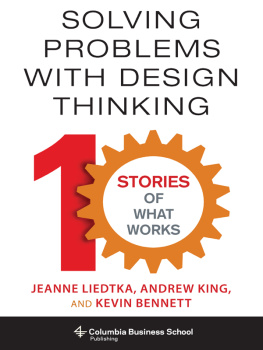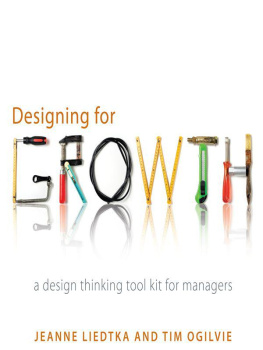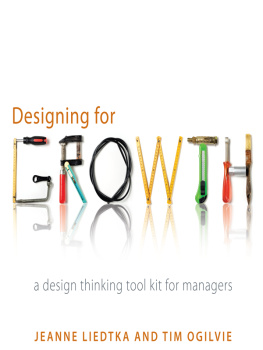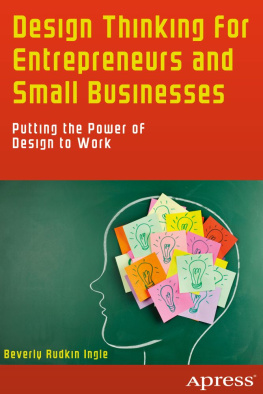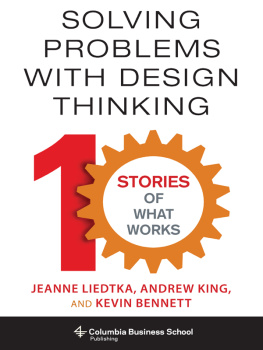First things first: Our profound thanks to the managers and designers who have shared their stories with us, for their generosity with their time, the candor with which they told their stories, and the insights that accompanied them. They were nothing short of remarkable. They inspired us to write this book: We felt a keen obligation to pass on to a broader audience all that they shared with us.
We also want to acknowledge the support and involvement of the Design Management Institute and, in particular, Tom Lockwood, who participated in many of our initial interviews.
The support of the Darden School, Dean Bob Bruner, and the Batten Institute has been essential to our ability to do the work that allowed us to produce this book. Our colleagues and friends at Darden have been a source of inspiration, learning, and encouragement, especially Ed Hess and Marian Moore, our partners in design crime.
And of course, as always, our deepest thanks to Amy Halliday, whose wise advice and superb editing make us sound so much better than we deserve.
From Jeanne
To Karen Musselman, who never hung up on me even though I was five hundred miles away and being a pain. To Rachel Brozenske and Tim Ogilvie, my very own design posse. Where would I be without you? To my family and friends for their support and encouragement, especially Debra and Matt, always there and always porch partners in crime, whose glasses of wine and wisdom I can always count on. And of course, above all, to my saintly beloved husband, Salz, who has saved my sanity so many times and in so many ways.
From Andrew
To Jeanne, who has been a first-class mentor, for taking me on this fantastic ride. To Mike Lenox and Sean Carr, who have supported my research efforts and doctoral aspirations. And most importantly, to my wife, Eva, whose inspiration has helped me in countless ways.
From Kevin
To Jeanne, a wonderful professor and mentor, who taught me the craft of design thinking, I remain eternally grateful. To Andrew, without whose impenetrable fortitude we would never have completed our journey, I thank you for your patience and generosity. To my Darden professors and classmates, you taught me more than you will ever know. And finally, to my saint of a mother, LuAnn Bennett, my inspirational brothers, Bryan and Richard, and to the worlds most patient and supportive girlfriend, Kristen Lamb, I say thank you.
MOST OF THE MANAGERS we meet harbor a deep, dark secret: They believe in their hearts that they are not creative. Picasso they know they are not. They also know that being seen as short on talent for invention in these days of innovation mania is almost as bad as not knowing how to populate an Excel spreadsheet.
It all seems so unfair. After years spent focusing on prudence and proving the return on investment of any new idea, years spent trying not to look stupid, now all of a sudden we are also expected not to lookwhat would the word be unimaginative ? And each time some creativity consultant asks us to imagine ten novel uses for a paper clip, it confirms what we already know: We are no Steve Jobs, either. For most of us there will be no Moses-like parting of the waters of the status quo that we might safely cross the Red Sea of innovation. Drowning is more likely our fate.
But despite popular misconceptions, innate genius isnt the only way to solve business problems creatively. Those of us who cant part the waters need instead to build a bridge to take us from current reality to a new future. In other words, we must manufacture our own miracles. And a technology for better bridge building already exists, right under our noses. What to call it is a matter of some dispute, but for lack of a better term well call it design thinking . Whatever label it goes by, it is an approach to problem solving that is distinguished by a few key attributes:
It emphasizes the importance of discovery in advance of solution generation using market research approaches that are empathetic and user driven.
It expands the boundaries of both our problem definitions and our solutions.
It is enthusiastic about engaging partners in co-creation.
It is committed to conducting real-world experiments rather than just running analyses using historical data.
And it works . Design thinking may look more pedestrian than miraculous, but it is capable of reliably producing new and better ways of creatively solving a host of organizational problems. Best of all, we believe that it is teachable to managers and scalable throughout an organization.
Despite some confusion over what to call itthe term design thinking sounds fuzzy to some people, and design is clearly about a lot more than thinkingprominent examples of companies applying the tools of design to improve business results come readily to mind in the wake of Apples success and IDEOs visibility, and many organizations now get the attraction of design thinking. Although some companies still appreciate designs power only for developing new products and services, organizations interested in innovation increasingly recognize it as a way to create new business models and achieve organic growth. In fact, using design thinking to identify and execute on opportunities for growth was the focus of our previous work. Now we want to take our exploration of designs potential a step further.
Our goal in this book is to push the visibility of design thinking in business and the social sector to new places and to demonstrate that design has an even broader role to play in achieving creative organizational and even civic outcomes. This book is built around ten vivid illustrations of organizations and their managers and design partners doing just thatusing design thinking in ways that work. Each story showcases a particular new use of design thinking. And each provides palpable examples of how organizations and individuals can stretch their capabilities when they approach problems through the design thinking lens. Using the voices of the managers and designers involved, we illustrate the value of a design thinking approach in addressing organizational challenges as diverse as reenvisioning call centers, energizing meals on wheels for the elderly, revitalizing a citys urban neighborhoods, and rethinking strategic planning.
Our ambitions here are grand: to offer a blueprint for deploying design thinking across levels and functions in order to embed a more creative approach to problem solving as a strategic capability in organizations.
Building Bridges with Design Thinking
Design thinking offers a great start to bridge building. It fosters creative problem solving by bringing a systematic end-to-end process to the challenge of innovation. A few years ago, Jeanne Liedtka and Tim Ogilvie, the CEO of the innovation strategy consultancy Peer Insight, wrote a book called

